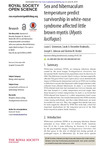Sex and hibernaculum temperature predict survivorship inwhite-nose syndrome affected little brownmyotis
| dc.contributor.author | Grieneisen, Laura E. | en_US |
| dc.contributor.author | Brownlee-Bouboulis, Sarah A. | en_US |
| dc.contributor.author | Johnson, Joseph S. | en_US |
| dc.date.accessioned | 2016-06-25T01:57:19Z | |
| dc.date.available | 2016-06-25T01:57:19Z | |
| dc.date.issued | 2015 | en_US |
| dc.identifier.other | HPU4160237 | en_US |
| dc.identifier.uri | https://lib.hpu.edu.vn/handle/123456789/21739 | en_US |
| dc.description.abstract | White-nose syndrome (WNS), an emerging infectious disease caused by the novel fungus Pseudogymnoascus destructans,has devastated North American bat populations since its discovery in 2006. The little brown myotis,Myotis lucifugus, has been especially affected. The goal of this 2-year captive study was to determine the impact of hibernacula temperature and sex on WNS survivorship in little brown myotis that displayed visible fungal infection when collected from affected hibernacula. In study 1, we found that WNS-affected male bats had increased survival over females and that bats housed at a colder temperature survived longer than those housed at warmer temperatures. | en_US |
| dc.format.extent | 7 p. | en_US |
| dc.format.mimetype | application/pdf | en_US |
| dc.language.iso | en | en_US |
| dc.publisher | The Royal Society | en_US |
| dc.subject | Biology | en_US |
| dc.subject | Ecology | en_US |
| dc.subject | Epidemiology | en_US |
| dc.subject | Behaviour | en_US |
| dc.title | Sex and hibernaculum temperature predict survivorship inwhite-nose syndrome affected little brownmyotis | en_US |
| dc.type | Book | en_US |
| dc.size | 405KB | en_US |
| dc.department | Education | en_US |
Files in this item
This item appears in the following Collection(s)
-
Education [806]

